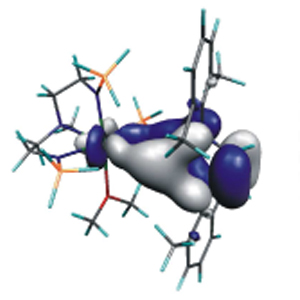A molecule featuring the first ever uranium-gallium bond may shed light on how related carbene ligands selectively extract uranium from lanthanides - an area of great interest to chemists looking for better ways to clean up nuclear waste.
The molecule, created by Steve Liddle's group at Nottingham University, UK, in collaboration with Cameron Jones of Monash University, Australia, is only the third with a uranium-metal bond to be structurally characterised. While x-ray crystal structure data indicated that the bond didn't rely on support from a bridging hydrogen atom - that is, that uranium and gallium were attached directly to each other - the team had to use computational modelling experiments to make sure, as such atoms can be very difficult to locate.
Much to the team's surprise, co-author Jonathan McMaster's density functional theory approach showed that not only was there no supporting hydrogen, but that the bond contained both sigma- and pi- character. 'This is the first observation of pi-bonding between low-valence group 13 metals and f-elements,' Liddle tells Chemistry World.

The gallium-uranium complex contains the first example of group 13 to f-element pi-donation, in addition to the gallium-uranium sigma bond
|
Liddle admits there is an 'astronomical distance' between his observation and a practical use for the uranium-gallium complex. But the gallium-containing ligand that was grafted to uranium has an electronic and orbital structure analogous to carbene ligands, whose uranium-binding properties have a more practical application: extracting the element from nuclear waste to ease processing.
Carbene ligands can selectively extract uranium from mixtures of lanthanides, but are unstable in aqueous environments, limiting their use in practice. The researchers speculate that the selectivity of carbenes for uranium over lanthanides could originate from pi-bonding much like that seen in the gallium complex - though no pi-bonding has been spotted in carbene complexes of uranium (IV). 'Is this study revealing something that carbenes have been doing in solution, but we haven't realised it?' Liddle asks.
Polly Arnold, a leader in the field of d- and f-block organometallic chemistry at the University of Edinburgh, UK, says the uranium-gallium complex is a 'nice addition' to the collection of bonds between f-elements and other, non-f-block metals. 'What interests me most is how reliant we all are on the computational work that describes the nature of the bonding in these systems, since we cannot simply correlate bond strength with length,' she adds.
Liddle hopes his team's discovery will prove useful to chemists who are trying to design new ligands for separating nuclear waste, and demonstrates the promise of chemistry that explores unusual ligands. 'It shows what fertile ground metal-metal bonding still is. It can really unearth new, interesting chemistry,' he says.
Tom Westgate




